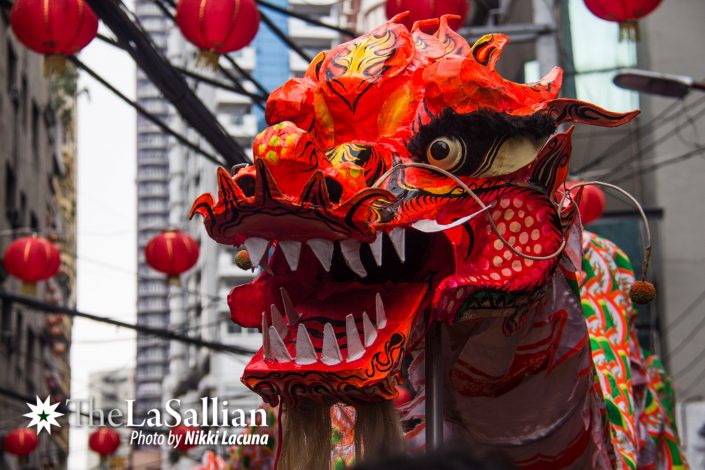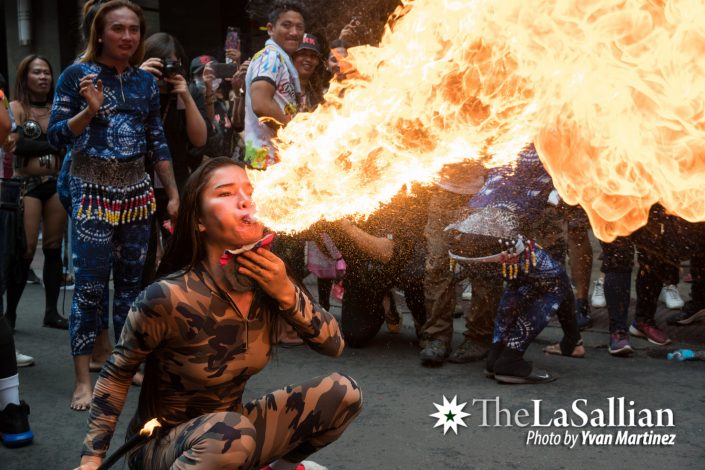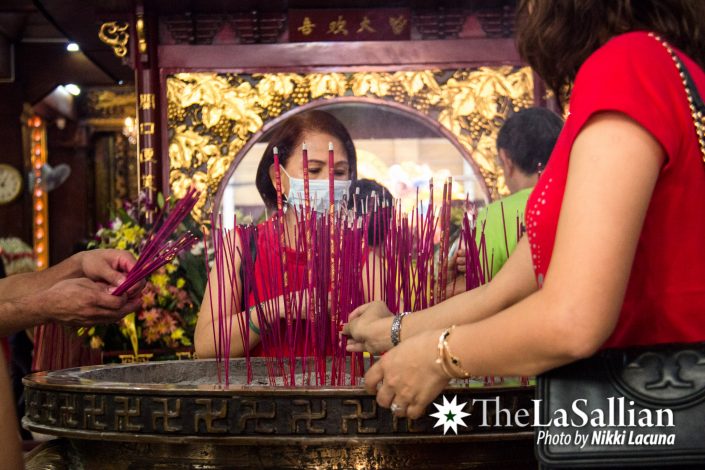A cool breeze blew across Ongpin on the morning of the first day in the year of the metal rat. Red lanterns littered the sky above our heads, suspended between buildings and on the edges of window sills. Street vendors laid out their products in sidewalk stalls adorned by red and yellow hues.
All was quiet until a firecracker’s sudden boom in the distance: smoke filled the air, then the majestic shapes of dragons and lions emerged, rearing their mighty heads. What a sight it was to behold as a sea of red flooded the streets. With people everywhere rushing to see the spectacle of the Lunar New Year, The LaSallian too found themselves in the midst of the chaos and cacophony enveloping Manila’s Chinatown.

Glenielle, Ongpin St.
“Déjà vu,” I thought, taking in the sight before me.
Time is a funny thing; only a year ago I was in the same place taking part in the same festivities. The familiar street brimmed with the trappings of the Chinese New Year, from the steady drum beats to the gliding dragons and lions. It was almost as if it was frozen in time—a moment when Binondo truly comes alive.
But of course, not everything was the same: the lucky charms peddled were no longer images of the pig, but of the rat; the crowd admiring the sleek dragon dances was considerably smaller; and most of the people out and about donned surgical face masks, their paces hurried—influenced perhaps by the recent viral outbreak in China?
The somber atmosphere didn’t last. Before long, the thrum of the drums grew louder, and people started congregating down the street. A shower of candies came raining down, prompting delighted shrieks and grappling hands as other trinkets like cookies and hand towels came in successive waves from Shoppers’ Mart. The big finale was a colorful cloud of confetti, eliciting cheers from the crowd whose worries were cast aside as they were momentarily entertained.
A popular store gathered quite an audience with their dragon dancers and mascots, the name “Eng Bee Tin” proudly emblazoned on the latter. But I found myself drawn to several children doing their own dragon dance using frayed carton boxes, with a pail nearby to collect coins from passersby. In the distance, I could hear the calls of fire dancers, beckoning with their red envelopes or ang pao, offering thrills for cash.
I realized then that these celebrations endured underneath a veneer of pomp and circumstance, serving as a much-needed respite from the world—even for a little while.
Westin, Salazar Bakery
The roaring celebrations along Ongpin St. overwhelmed me, so I sought out a moment of repose in Salazar Bakery. I remembered going to the store with my parents and grandparents when I was younger. I don’t remember it being as packed back then as it is now.
Droves of customers scanned the shelves filled with hopia and pandesal throughout the shop. There were two cash registers open, with the lines before them extending to the door of the bakery. Family members yelled at each other from across the tiny bakery in rapid Fukien that I could only barely understand.

I examined the available options and settled on salted egg hopia and mung bean cake. They were as delicious as I remembered them being from past New Year’s experiences. With a single bite, the hopia’s flaky exterior made way to a rich, creamy paste on the inside, the salted egg taste strangely complementing the sweet-flavored filling. The mung bean cakes were smaller, barely larger than a five-peso coin. The cake’s breading was crunchy, blending nicely with the earthy, red bean flavor on the inside.
I happily exited the bakery, offering my fellow staffers a share of the pastries. They politely declined.
That was fine. More for me to enjoy.
Patrick, Seng Guan Temple
Strangely enough, many of the people who celebrated the glimmering red of the Lunar New Year were not the Chinese, but instead the local Filipinos who lived in the heart of Binondo.
Having adopted the culture and even the religious traditions of the Chinese in the area, they seemed to enjoy the practices not rooted in their own blood, but from the localized Chinese who now call Binondo, the oldest Chinatown in the world, their home. The energy on the streets was overwhelming, transmitting the feeling from ages past of one’s ancestors dancing with lions and dragons.
Yet as the local Filipinos danced and cheered in what seemed to be a festival of raw bodily movement, the Filipino-Chinese who supposedly brought this tradition into the country were missing from view.
And we found them—kneeling before large statues and images of Buddhist deities and other celestial beings, they sought wise counsel and asked for good fortune as the new year began.
It seemed like a good number of the local Filipino-Chinese community did not want to walk in the glimmering heat amid the crowded streets. Instead, they sought shelter under the roof of a temple, praying for auspicious blessings for the coming year.

Yet in the end, who is to say which practice is more appropriate? Belonging to a Chinese family that usually celebrates the Lunar New Year with dinner at a Chinese restaurant, I realized that each group celebrates the holiday in a different way. Whether one is enjoying Chinese cuisine with the family, enjoying the festive dances in the streets of Binondo, or paying respects to the deities above, these are all viable options that are to be equally respected and understood.
Westin, Quik Snack
It didn’t take long for my mind to wander to food once again. It certainly seemed like I was the only one in that headspace, with my fellow staffers politely nodding as I suggested grabbing an early lunch only a little over an hour after devouring the pastries.
I couldn’t help it; going into the celebrations, I was most excited for lunch. A number of Chinese relatives and friends recommended Quik Snack, apparently a quintessential Chinese dining experience for those living in Binondo. A little way off the path of Ongpin and through a maze of fruit stalls was the restaurant, almost hidden by a wall if not for its low hanging sign.
Seated at a round table at the back, I felt my friends’ eyes fall on me to decide on our order. Pressured to deliver a feast for them, I thought to myself what my grandmother—an expert on all things Chinese—would do in this situation. I ordered misua, remembering that the noodles represented a long and bountiful life, and some shrimp kikiam, with shrimp symbolizing happiness and good fortune in Chinese culture. I also ended up throwing in an order for fried chicken. Who doesn’t like fried chicken?
Though I began to question whether or not I remembered my Chinese traditions correctly shortly after ordering, there was no question on quality when the food finally arrived. The misua was bountiful and rich, coated in a slightly spicy, herbal sauce, and accompanied by finely roasted pork bits. My companions weren’t too familiar with the kikiam, but tasting how the crispy exterior complemented the salty shrimp and pork center, we nonetheless finished the entire plate together. The fried chicken ended up being the cherry that capped off the whole meal—the golden-brown skin was delightfully crunchy, and the rich, white meat oozed with tangy, savory flavors.
Sitting with an empty plate before me, and my belly a little bit rounder, I shared a knowing smile with my friends. Celebrations often bring the most delicious delicacies; I’m so glad this new year did not disappoint.
Glenielle, Binondo
With our bellies full and our spirits high, we stepped out once again into the heart of the festivities. The crowd was livelier than ever, raucous laughter and gasps of wonder constantly erupting as they watched the performances. Phones were bravely out—no heed paid to the possibility of theft—as people rushed to document their day out with loved ones, each finding their own space against the backdrop of chaos.
Time really is a funny thing; despite the certainty that the same festivities will occur perpetually, the charm of Chinese New Year will be ever-present and unwavering.
